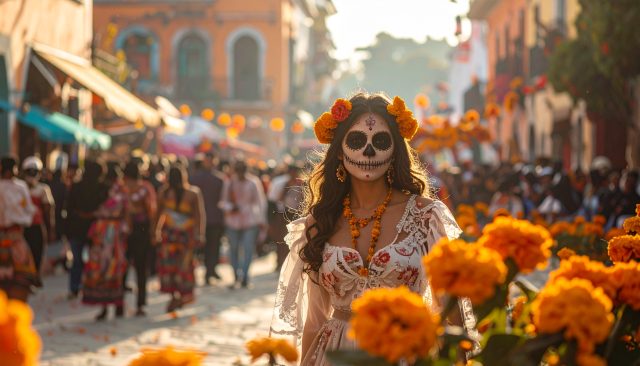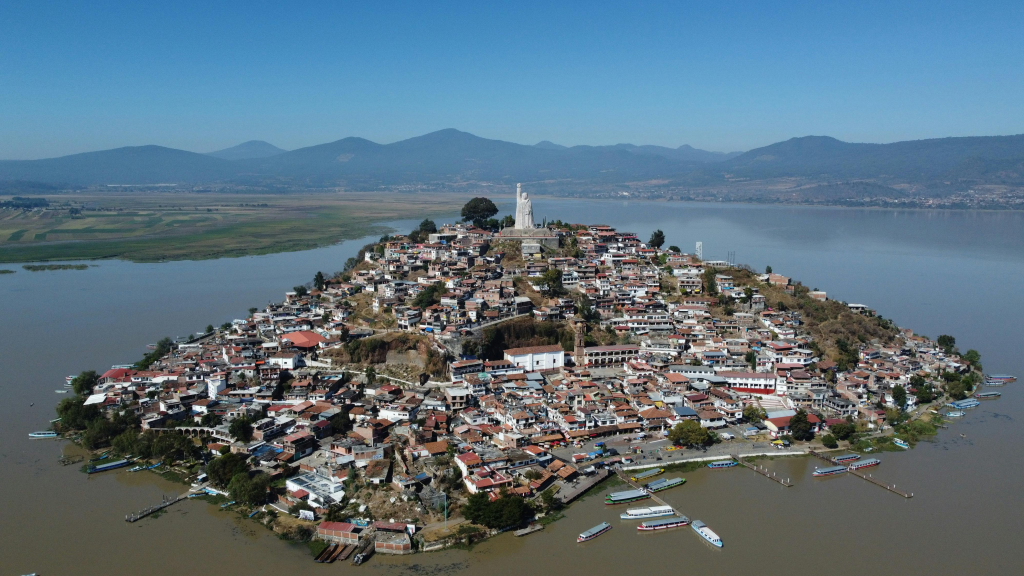Día de los Muertos, or the Day of the Dead, is one of the most captivating celebrations in Mexico. Each year, from October 31 to November 2, families honor the spirits of their departed loved ones with altars, marigolds, candles, and food. The celebration dates back to pre-Hispanic times, blending Indigenous beliefs with Catholic traditions to create a festival that celebrates life through death.
Altars known as ofrendas are built in homes, schools, and cemeteries, decorated with sugar skulls, photographs, and favorite foods of the departed. Cemeteries glow with candles while streets fill with color, music, and people painted as calaveras. This festival is not about mourning but remembrance, love, and continuity.
Each region of Mexico offers its own unique take on the celebration. From lakeside vigils to grand city parades, the experience is always powerful and emotional. If you plan to travel for the Day of the Dead, these ten breathtaking places in Mexico showcase the country’s spirit, art, and heart at their most extraordinary.
10. San Miguel de Allende, Guanajuato
San Miguel de Allende is known for La Calaca Festival, a four-day celebration filled with art, music, and processions. The city’s cobblestone streets transform into a vibrant display of face-painted revelers, parades, and artistic performances celebrating life and memory.
San Miguel de Allende is among the safest tourist destinations in Mexico. The historic center is well-patrolled, and locals are welcoming to visitors. However, it is best to stay in central areas and keep personal belongings secure in crowds.
For travelers seeking a festive yet elegant celebration, San Miguel de Allende offers an unforgettable mix of art, culture, and tradition.

9. Huaquechula, Puebla

In Huaquechula, Día de los Muertos is celebrated with ofrendas monumentales, massive three-tiered altars created to honor loved ones who have recently passed away. Families invite visitors into their homes to view the altars, each one a masterpiece of devotion.
Huaquechula is peaceful and safe, with friendly locals who take pride in sharing their customs. Because it is a small town, accommodations are limited, so it’s best to book early or stay in nearby Puebla City.
This intimate and spiritual celebration offers travelers a deeply authentic glimpse into the heart of Mexican tradition.
8. Aguascalientes
Aguascalientes celebrates the Festival de las Calaveras, or Festival of Skulls, a lively event that fills the streets with parades, concerts, theater, and art. The festival pays tribute to José Guadalupe Posada, creator of Mexico’s famous La Catrina figure.
The city is considered very safe for tourists, with excellent infrastructure and security during the event. It’s best to stay near the historic center, where most festivities occur.
Aguascalientes offers an energetic and creative way to experience Día de los Muertos, perfect for visitors who love art and music.

7. San Juan Chamula, Chiapas

San Juan Chamula, located in the highlands of Chiapas near San Cristóbal de las Casas, offers one of the most unique and spiritual Día de los Muertos experiences in Mexico. Here, Indigenous Tzotzil Maya traditions blend with Catholic customs in a way found nowhere else in the country. Families decorate graves with pine needles, candles, and flowers, while ceremonies in the town’s church combine ancient rituals with modern devotion.
Travelers will find San Juan Chamula safe when visited with respect and awareness. The local community is protective of its customs, so photography inside the church is strictly forbidden. It’s best to visit with a local guide who can explain the traditions and ensure visitors behave appropriately.
This destination is ideal for travelers seeking authenticity and cultural depth. The Day of the Dead here feels raw, sacred, and deeply rooted in centuries-old Indigenous belief — a profound reminder that life and death remain eternally connected in Mexico’s soul.
6. Mérida, Yucatán
In Mérida, the celebration is known as Hanal Pixán, which means “Food for the Souls” in Mayan. Families prepare mucbipollo, a special tamale baked underground, and the city holds the Paseo de las Ánimas, a candlelit procession of people dressed as spirits.
Mérida is one of the safest cities in Mexico, and travelers can comfortably explore even after dark. Stick to official events and central areas for the best experience.
With its mix of Mayan heritage and colonial beauty, Mérida offers a calm, spiritual take on Día de los Muertos that feels both meaningful and serene.
5. Janitzio Island, Michoacán
Janitzio Island, set in the middle of Lake Pátzcuaro, hosts one of the most mesmerizing Day of the Dead celebrations in Mexico. Families cross the lake in candlelit boats to spend the night in the island’s cemetery, singing and praying for their ancestors.
Janitzio is generally safe, but visitors should plan ahead. Travel with a tour or local guide, especially for the night crossings, and reserve accommodation early since space is limited.
This experience is pure magic — the reflection of thousands of candles on the lake captures the essence of love, memory, and peace.
4. San Andrés Mixquic, Mexico City
San Andrés Mixquic offers one of the most traditional celebrations near Mexico City. During La Alumbrada, the cemetery fills with glowing candles as families welcome their loved ones’ spirits back for the night.
Mixquic is safe and organized during the festivities, though it becomes very crowded. It’s best to arrive early, use rideshare services instead of driving, and stay near the main plaza.
For travelers seeking authenticity without leaving the capital, Mixquic is a moving and unforgettable place to experience the Day of the Dead.
3. Pátzcuaro, Michoacán

Pátzcuaro’s lakeside setting makes it one of Mexico’s most famous Day of the Dead destinations. Families prepare offerings, decorate graves, and travel to nearby Janitzio Island by candlelit boat. The reflection of the lights on the lake creates a breathtaking scene.
Pátzcuaro is tourist-friendly and safe, though visitors should book early and stay alert in large crowds. The town becomes busy during the holiday, but locals are kind and welcoming to respectful travelers.
Pátzcuaro’s deep Purépecha heritage and serene beauty make it a perfect place to experience the heart of Día de los Muertos.
2. Mexico City
Mexico City hosts one of the world’s grandest Day of the Dead celebrations. The parade along Paseo de la Reforma features massive floats, dancers, and elaborate costumes inspired by Mexican folklore and art. Meanwhile, traditional neighborhoods such as Mixquic preserve the more spiritual side of the festival.
The city is safe for tourists in main event areas, with strong police presence and good public transport. Avoid isolated areas at night and keep belongings secure.
Mexico City combines spectacle, history, and heart — offering travelers a complete experience of how modern Mexico celebrates its ancestors.
1. Oaxaca City
Oaxaca City is widely considered the best place in Mexico to experience Día de los Muertos. Its streets overflow with parades, markets, and candlelit gatherings. Locals create stunning sand tapestries called tapetes de arena and fill cemeteries in nearby Xoxocotlán with light and music.
Oaxaca is safe for visitors, especially in central areas, and police patrols are increased during the celebrations. Travelers should respect local customs when entering cemeteries and plan ahead for accommodation, as hotels fill quickly.
Oaxaca’s powerful mix of Indigenous traditions, community spirit, and visual beauty makes it the most unforgettable destination for Día de los Muertos in Mexico.



